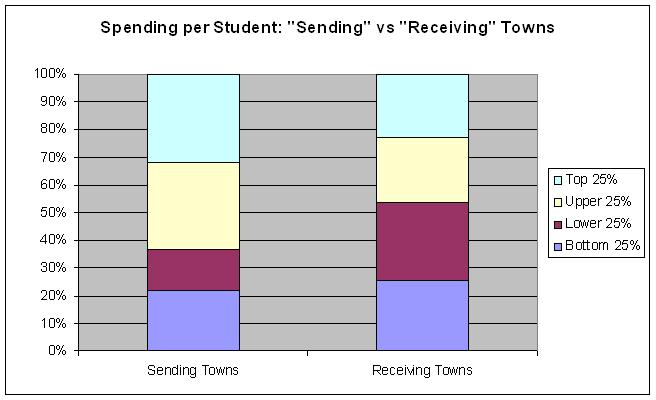
Are "receiving" towns driving up costs?
Under Acts 60 and 68, there are so-called "sending" towns and
"recieving" towns. "Sending" towns are those that raise more
in
education taxes than they spend on education locally. As a
result, they "send" the additional education tax dollars for use by
"receiving" towns. "Receiving" towns are those that raise
less in
education taxes than they spend locally and as a result "receive" the
funds needed to cover the remaining expense. Essentially,
these
funds come from the "sending" towns. It is sometimes
suggested
that because "receiving" towns can approve budgets for amounts beyond
what will be raised locally in tax dollars and have the difference
covered by "sending" towns, they will be more likely to increase
education spending. Analysis of actual data suggests that this is not
in fact happening.
For this analysis, the towns were divided into two groups.
"Sending towns" were defined as those whose 2005 education
taxes
raised exceeded their 2005 education spending budget.
"Receiving
towns" were defined as those whose 2005 education taxes raised were
less than their 2005 education spending budget. For the entire
list of towns, each town was "bucketed" based on how their
spending per pupil compared to all other towns. The buckets
were:
- Top 25% -- towns in this bucket were in the top 25% of
towns in spending per pupil (i.e. had the highest spending per pupil)
- Upper 25% -- towns in this bucket were above the bottom 50%
and
below the top 25% in spending per pupil (i.e. high but not the highest)
- Lower 25% -- towns in this bucket were below the top 50%
and
above the bottom 25% in spending per pupil (i.e. low but not the lowest)
- Bottom 25% -- towns in this bucket were in the bottom 25%
of
towns in spending per pupil (i.e. had the lowest spending per
pupil)
As the graph below illustrates, "sending" towns are more likely to be
in the "Top 25%" and "Upper 25%" of spending per pupil than "receiving"
towns.
Here's the same information presented in tabular form:
| Spending per Student |
Sending
Towns |
Receiving
Towns |
| Bottom
25% |
13 |
50 |
| Lower
25% |
9 |
55 |
| Upper
25% |
19 |
45 |
| Top 25% |
19 |
45 |
Copyright (C) 2006 by Ken Dufort